- Home
- Deborah Harkness
The World of All Souls Page 6
The World of All Souls Read online
Page 6
In short, daemons leave things everywhere, take apart objects clearly labeled “Do not disassemble,” are impossible roommates, and have to make do as square pegs in a round-hole world.
Genetics and Reproduction
Daemons have twenty-three chromosomal pairs just like humans but have a single extra chromosome in addition. At least one scientist believes this may be what makes them daemonic and prone to instability. But laboratory research into the daemonic genome is in its infancy, and those conclusions are purely speculative. In many respects daemons are the least understood and hardest to categorize of the creatures. Some daemons believe that the answers to their origins lie in the Book of Life. As Agatha Wilson said to Diana, “It tells our story—beginning, middle, even the end. We daemons need to understand our place in the world. Our need is greater than that of the witches or vampires.”
No one understands how and why daemons are made. They are not consistently born from other daemons in the way witches are born from other witches or vampires are made by other vampires. The origins of daemons are complicated, with many being born to human parents, daemon parents, or some combination thereof. There are also rare instances where witches give birth to daemons—for example, Sophie Norman was the child of two witches. But as with most aspects of daemonic culture, these instances have not been systematically studied. This is largely because the presence of daemons has been hidden from public view for many centuries. Those few scientists who are daemons themselves or are aware of the existence of daemons have long felt it was too dangerous to publicly acknowledge any creatures other than humans. There is some cause for hope that the present scientific community would respond to an inquiry into daemon genetics with a spirit of investigation rather than with prejudice and hostility, as modern scientists are trained to rely upon data and evidence rather than superstition and belief.
Matthew’s research into creature genetics, in conjunction with the secrets Diana has unlocked from the Book of Life, has now revealed that daemon genes are the critical link for cross-creature reproduction and the conception of Bright Borns between witches and vampires.
Customs and Lore
Daemons do not have a society in the traditional sense and little collective identity, due to the unpredictable nature of their descent. This is in stark contrast to witches and vampires. It makes daemons perpetual outsiders, marginal even within the world of creatures.
Three daemons sit on the Congregation, along with three witches and three vampires, and vampires are forbidden to take daemons’ blood. This would suggest that daemons are accorded respect by these other creatures, but their treatment by witches and vampires does not bear this out. Both creatures look down on daemons, finding them erratic, difficult to understand, and unreliable. These prejudiced views are being eroded with the formation of the Conventicle, in which daemons (such as Nathaniel Wilson) are asserting their value and standing beside their vampire and witch counterparts. But it will take time for centuries-old biases to change completely.
Daemons long to know where they come from, for a narrative of their history and a sense of how they came to be and when. Most suffer terrible loneliness in childhood, having formed the unsettling conclusion that they are vastly different from most people. Those fortunate enough to discover that they’re members of a group of creatures called daemons have described the moment as a rebirth and an opportunity for community and belonging.
With this marginalization and lack of formal customs or lore, daemons have developed many different ways of coping. As daemons mature, some find themselves living alone and in such cases often decide to share their homes with companion animals. The numbers of their pets are likely to be more than most other creatures deem sensible. For example, instead of having one dog lying quietly at their feet, they’ll have a half dozen—each one louder, more badly behaved, and more headstrong than the last. These are unlikely to be completely housebroken. The term “crazy cat lady” refers to the same daemonic phenomenon.
Still, despite their domestic eccentricities, few daemons live entirely solitary lives. Many form strong attachments to others, both romantic and platonic. Daemons are tremendously affectionate and loyal to their friends and loved ones. But in some situations these qualities can tip over into madness and obsession, and in their single-mindedness and ardor daemons can destroy goodwill and even lives (the serial killers). With the advent of the Internet, many young daemons have found solace and like-minded opponents in the online gaming community and often continue to play computer games as adults. Others find they enjoy more unplugged games of strategy, like chess and the Chinese form of it, Xiangqi. Many daemons practice yoga and meditation, which they find helpful for managing and balancing their intense energy and allowing them simply to be themselves without the constant reminders of their difference.
Daemons are drawn to energy in its many forms. They tend to hang around in markets, concert halls, restaurants, libraries, and other places where there is great industry, intellectual activity, and creativity. And because daemons can sense all kinds of energy, including magic, they are irresistibly attracted to witches, especially powerful ones. The fascination is nearly always one-sided, but this does not seem to discourage daemons in the least. In these cases daemons are likely to draw human attention while shuffling dreamily behind some beleaguered witch. In the main, however, adult daemons avoid hanging around vampires or witches. They prefer to stick together or move among the humans, who vaguely fear their difference and alternately marvel at and envy their inhuman brilliance.
Daemons learn to avoid locales where they are especially persecuted and gravitate toward those few places they are welcomed, like Rudolf II’s Prague at the end of the sixteenth century and Silicon Valley in the twenty-first. Generally speaking, however, daemons have been increasingly marginalized and vilified. Their social disorganization, due both to the circumstances of their birth and their innate disposition, militates against the rise of any set of formal customs. For their stories and lore, they rely largely upon fragmented human accounts.
Myth and History
The fractured nature of daemon culture means they have no recorded, coherent history, only tales told about them by fearful and envious humans. In ancient times humans understood and valued the gifts of daemons, who occupied a place somewhere between themselves and the gods. They were recognized as possessing godlike spirits, animated by their intense interests and passions. But over time, and with the advent of the monotheistic religions, daemons came to be associated with false idols or fallen angels and evil in the minds of many humans. Rather than revering their godlike and creative spirits, humans viewed daemons as demons, creatures who needed to be exorcised from existence by the church. Humans came to hate them because they were different and abandoned their own children if they turned out to be daemons. Even in modern times, exorcisms of demons are practiced by humans of many faiths. These human tales tend to frighten the general population and popularize the association between daemonic behaviors and evil.
There is some anecdotal evidence to suggest that, over time, madness and instability have increased among daemons. This coincides with a rise in the practice of confining the insane in institutions along with criminals, debtors, and other troublesome inmates. As early as the ninth century, daemons began to be kept apart from the rest of society. London’s Bedlam hospital has housed daemons from the thirteenth century. We know from Diana Bishop’s visit to Bedlam in 1590 that even then a majority of its inmates appeared to be daemons. They became the focus of human attention particularly in the late eighteenth and early nineteenth centuries when reform of mental asylums became a priority. During this time, some humans and many creatures, most of them daemons, were institutionalized at exponentially higher rates than in previous years. Indeed, the official reasons for admittance to nineteenth-century asylums reads like a catalog of daemonic characteristics, ranging from overexertion, mania, and monomania to novel reading, ke
eping bad company, and suffering from greediness, jealousy, dissolute habits, and insomnia. Now, with a new age for creatures opening up as the result of genetic research and the overturning of the covenant, daemons may finally come to understand their fragmented history and origins. One of the most famous daemons, Christopher Marlowe, encapsulated the contradiction of a daemon’s experience in his observation, “What nourishes me, destroys me.”
See also:
CHARACTERS: Thomas Harriot, Edward Kelley, Christopher Marlowe, Sophie Norman, Hamish Osborne, Timothy Weston, Agatha Wilson, Nathaniel Wilson
ORGANIZATIONS: The Congregation, the Conventicle
Humans
Humans outnumbered us and found our power frightening, my mother explained, and fear was the strongest force on earth.
Characteristics
Humans are rational, sensitive beings who thrive in the company of others. They show talent in many different ways, ranging from academic interests to more practical endeavors. They may not possess the physical strength of vampires, the intense creativity of daemons, or the magical power of witches, but in terms of number they dominate the All Souls world. They are especially gifted when it comes to denial and fear responses and can activate their usually dormant sixth sense when a situation demands it. They are the ultimate prey animals and have adapted to respond to fear with aggression. This has kept their numbers up and has negatively affected other creature populations. The powers of witches and the enhanced strength of vampires are no match for the collective potency of human fear.
Humans, having long represented the creature majority, enjoy the many privileges of that status. They also exhibit the myriad weaknesses inherent in that position, namely a sense of entitlement, the tendency to screen out inconvenient and unpleasant truths of existence, and a cavalier attitude toward squandering resources.
Humans often turn a blind eye to the peculiar activity of the other creatures in their midst. However, they are not as clueless as they seem. They do know that there are different creatures in the world. Humans look twice at the beautiful, graceful vampires they see on the street; they are envious of the talents of daemons and follow rock stars and movie stars with avid attention; they have delusions of grandeur that make them fascinated with magical stories and troop in large numbers to theme parks and the cinema to see tales of witches and wizards. But humans compartmentalize these experiences, dismissing them as illusions or make-believe. There are, of course, exceptions to these human deniers, and at an individual level many display warmth and calm acceptance. When Diana finally revealed to her close friend Christopher Roberts what she and Matthew really are, he processed the evidence as any open-minded scientist should and accepted the seemingly impossible into his worldview.
If you are reading this, you know what humans look like.
Genetics and Reproduction
Genetically, humans possess the normal twenty-three chromosomal pairs in every cell nucleus. Creatures may appear similar to humans on the surface, but their genetic makeup is very different, with vampires and witches having twenty-four chromosome pairs (daemons have the same number of pairs as humans, but a single extra chromosome).
Humans give birth to other humans and can have children who are daemons, but only rarely. They cannot have children who are witches or vampires, though their offspring can be transformed into vampires. If current demographic trends continue, humans are likely to surpass the other three creature populations within several centuries.
Over time humans have proved better at adapting, with a stronger urge to reproduce than vampires and witches, and their immune systems are more responsive to the stresses of modern life. It’s these sensitive immune systems, however, that vampire researcher Miriam Shephard believes are going to get humans in the end. The human ability to adapt, through natural selection and species extinction, is the concept from Charles Darwin’s Origin of Species that kindled Matthew’s interest for his own research on creatures, contributing to his theory that humans, witches, daemons, and vampires could in fact all be descended from a common ancestor. As he and Diana went on to discover, humans are not so far removed from these other creatures genetically as they seem to be.
Customs and Lore
Humans are drawn to creating ever more complicated and exclusive social organizations and institutions. This provides them with strong foundations when it comes to rationalizing and organizing responses to creatures Not Like Them.
In a similar way to other creatures, humans seek out a partner in life. They arrange themselves in family groups surrounding these central partnerships. But the bonds that hold them do not have the strength of vampire matings. They are capable of cutting their ties to a once-beloved partner, or even turning on their family, if motivated by fear and the desire for power.
Some humans are more knowledgeable about the world of creatures and, rather than living in denial, adopt a practical, peaceful option of mutual coexistence. Witches have found it beneficial to become established members of human communities, where their talents for healing and guidance are appreciated. Vampires, too, sometimes live in an area long enough to become fixtures of local life. The de Clermonts, for instance, are known in their village to be vampires, but their human neighbors have been protected and supported by the clan long enough that the family has earned their unfailing loyalty.
History and Myth
The history of humans goes as far back as that of all other creatures. As with daemons, vampires, and witches, the truth of their past experiences is hidden somewhere within myth and stories, in the source-biased accounts of historians, and in the evidence pieced together by scientists. Human creation stories are as varied and numerous as the multiple religions and cultures they stem from, as are human tales of the other creatures in their midst. It is these belief systems, with their corresponding alliances and clashes, that have driven the shape of events in their societies.
Humans used to be more equal in numbers to vampires, witches, and daemons. Over the centuries, however, their powers of denial and fear were channeled into the persecution of those “others” who raised their heads above the parapet. This led to human dominance in the All Souls world, driving creatures into the hidden minority. A particular turning point for human ascendency in the West came during the medieval period and the Crusades.
Religious and racial conflict among humans has always been a key feature of their history, and the wars that ensued drew in all the other creatures. The medieval Crusades, from the eleventh century to the end of the fifteenth, were a time when Western knights flocked to the Holy Land to do battle against their infidel enemy and the European myth of the chivalric medieval knight was at its height, symbolized in the order of the Knights Templar. Many creatures joined the humans in their quest, including the de Clermonts. But each community of creatures had its own agenda, and as tensions mounted, witches, daemons, and vampires were forced to retreat from the threat of dangerous human attention. So the Congregation and its covenant were formed to protect and separate creatures as far as possible from human society and its politics.
Although on the surface humans were the reigning elite, in reality, vampires, witches, and daemons found other ways to wield power. Forbidden to rule, they continued to work (and do still) behind the scenes in human affairs, interceding and manipulating events if the situation required it. When Diana timewalked to the sixteenth century, there was no denying the strong grip that Philippe de Clermont’s network of vampires had upon Europe and its rulers. At that time Philippe was caught up in trying to save France from itself, locked as it was in the split between Protestants and Catholics following the bloody St. Bartholomew’s Day Massacre in 1572 that occurred during the wedding of a French Catholic princess to the future Protestant king Henri of Navarre. Catholic mob violence and assassinations swept through the city, directed against the Protestant French Huguenots. Matthew played his part on that infamous day, using one of his many ide
ntities to help the English ambassador, Francis Walsingham, escape Paris with his Protestant friends.
While creatures have sought to control human affairs, astute human rulers in history have known how to exploit the talents of the creatures while never publicly acknowledging that they even exist. Sixteenth-century sovereigns Elizabeth I of England and Holy Roman Emperor Rudolf II were fully aware of the creatures in their kingdoms. As long as the creatures served their interests, they allowed them a safe haven. Matthew Roydon, Elizabeth I’s vampire spy, was a valuable servant to the queen. Rudolf’s fascination for the occult and his fondness for the witches whose magic and power he desired made his court a particular gathering place for witches as well as daemons. And both Elizabeth and Rudolf were determined to assert their ownership over the mad daemon genius Edward Kelley and his alchemical work if it meant they could acquire the elusive philosopher’s stone. But the whims of these rulers were a dangerous tightrope for creatures. A king’s or a queen’s interest could turn instantly deadly if the monarch sensed a threat to his or her power, as the Scottish witches in King James VI’s kingdom discovered.

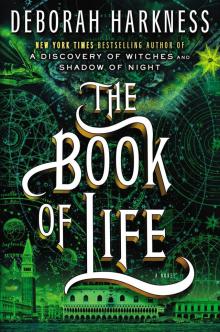 The Book of Life
The Book of Life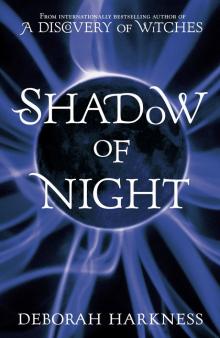 Shadow of Night
Shadow of Night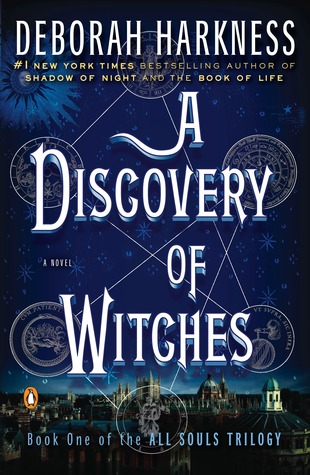 A Discovery of Witches
A Discovery of Witches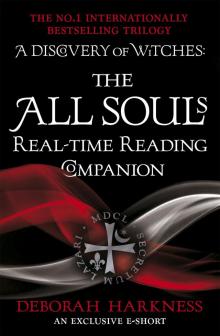 The All Souls Real-Time Reading Companion
The All Souls Real-Time Reading Companion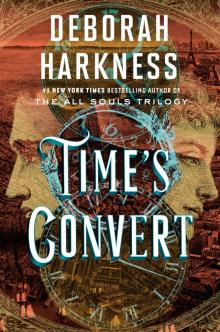 Time's Convert
Time's Convert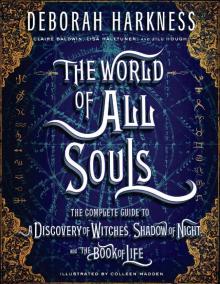 The World of All Souls
The World of All Souls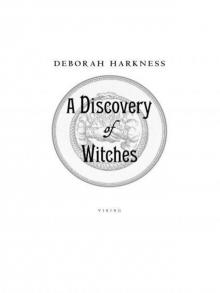 A Discovery of Witches: A Novel (All Souls Trilogy)
A Discovery of Witches: A Novel (All Souls Trilogy) Shadow of Night: A Novel
Shadow of Night: A Novel